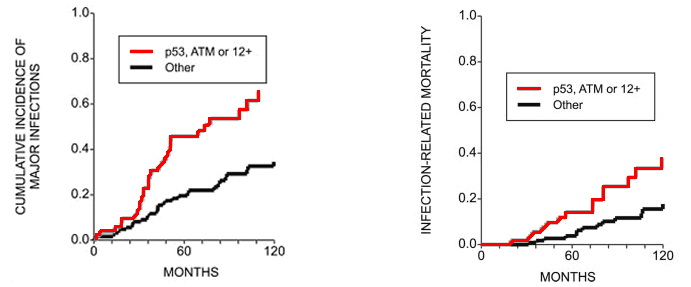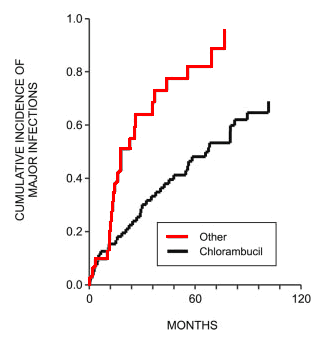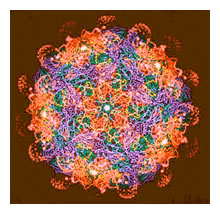 |
||||||||||
Date: September 6, 2026
by Chaya Venkat
Index Page for Articles on

At the risk of repeating the obvious, CLL is a cancer of the immune system that is supposed to protect us from infections. It follows from this that people with CLL have less than effective immune defenses, are therefore more likely to contract infections and, once infected, are more likely to die from them. Infections are the single biggest killer of CLL patients. So, if your oncologist told you at your CLL diagnosis that you are not going to die from CLL, that when you die it is most likely going to be from something else, he was partly right. The part he may have left out is this: the “something else” that is likely to kill you is an uncontrolled infection caused by the CLL or treatment for it. If you are new to the CLL scene or need a refresher course on the subject of infections, you may want to look up a few of the articles cited below in the editorial section of this article.
Two recent Topics Alerts in recent days (#192, #193) generated a lot of feedback from our members - so much so that I decided to make the content of those Alerts into this full fledged review for publication on our general website. While our Topics Alert membership keeps growing, not every one who visits our website has registered to receive email Alerts and PC does not get around to updating the archive of Alert messages for a month or so. (By the way, registration for our email Alert service is entirely free of charge and here is the link to the Alert Registration page if you wish to register.)
Not everyone was thrilled with me for sending out these two Alerts. Some people were upset and did not see the point of my worrying them. I fully agree, the information in this article can be troubling, especially if you happen to be holding the short end of the stick and have a high risk profile. You may not want to know the bad news, that you may be at higher risk of infections than the average Joe CLL patient walking down the road. I can understand that, even sympathize with you for not wanting to dwell on this but I most emphatically do not agree that ignoring inconvenient truths is the best path to long term survival. Me, I am fully convinced that we cannot fight an enemy we do not understand. Knowing the risks we face is the first step in defending ourselves. The Cancer 2026 article reviewed below is an example of “Best Practices” in defining who amongst us is most at risk, and what they can do about it.
“Best practices”: Infection Risk Definition for CLL Patients
Cancer. 2026 Sep 1;107(5):1023-33.
The effect of immunoglobulin V(H) gene mutation status and other prognostic factors on the incidence of major infections in patients with chronic lymphocytic leukemia.
• Francis S, Karanth M, Pratt G, Starczynski J, Hooper L, Fegan C, Pepper C, Valcarcel D, Milligan DW, Delgado J.
Department of Hematology, Birmingham Heartlands Hospital, Birmingham, United Kingdom.
BACKGROUND: Infections are a major factor in the clinical course of chronic lymphocytic leukemia (CLL) and account for 30% to 50% of all deaths. The pathogenesis of infections in CLL is related to hypo-gamma-globulinemia, T-cell immune dysfunction, and the immunosuppressive effect of treatment.
METHODS: The authors retrospectively assessed the correlations between new prognostic markers and types of infections encountered, the time taken to develop these infections, and infection-related mortality in 280 unselected patients with CLL.
RESULTS: One hundred patients (36%) had at least 1 major infection (median, 2 major infections; range, 1-8 major infections) over a median follow-up of 67 months. Infections were the most common cause of death, accounting for 51% of all fatalities. Older age (P = .007), clinical Stage B or C disease (P < .001), unmutated immunoglobulin (Ig)V(H) gene status (P < .001), genetic abnormalities (P < .001), positive CD38 status (P < .001), and type of initial therapy were associated with a significantly shorter time to first infection. Equally, patient age (P < .001), disease stage (P < .001), CD38 expression (P < .001), IgV(H) mutation status (P < .001), and genetic abnormalities (P = .003) had a significant impact on infection-related mortality.
CONCLUSIONS.: Clinical stage at diagnosis, IgV(H) mutation status, and initial therapy were possible predictors of severe infections in patients with CLL. The current results may help to identify which patients with CLL are at particularly high risk of developing serious infections and, thus, should be considered for Ig or antibiotic prophylaxis.
Cancer 2026. (c) 2026 American Cancer Society.
PMID: 16862572
____________
This is a very nicely done retrospective study using a large number of CLL patients (280 of them). I found it difficult selecting just a few tidbits of this article for your browsing pleasure. But here are a few quotes that should get your juices flowing. Write to us if you wish to read the full text of the article.
The most interesting part of this paper is that it looks at the CLL patient population from the perspective of their prognostic indicators, the first time I have seen that done. Probably the most important thing we have learned in the last few years is that one size does not fit all CLL patients, not when it comes to risk stratification, therapy choices, or preventive measures needed to protect against infections. They say a picture is worth a thousand words. Below are a few that you might find useful as you ponder your own situation.

IgVH gene mutation status predicts risk of serious infections. It is well known that IgVH gene mutation status is the single best predictor of how a CLL patient is going to progress over time. This is the first paper I have seen that clearly identifies the predictive power of this important prognostic indicator in defining risk of serious infections — and death as a result of those infections. The curves for the mutated IgVH (good) and unmutated IgVH type (bad) versions of CLL cannot be more different. If you are in the unmutated group, you have much higher risk of getting serious infections, and dying as a result of them. You had better start taking this stuff seriously, if you want to have many more happy birthdays. Head in sand is not a good strategy for you.

Chromosomal aberrrations predict risk of serious infections. Another prognostic indicator that has a big impact is the presence of unfavorable chromosomal aberrations, as measured by FISH. The usual culprits are involved, just as in predicting risk of CLL progression. Defects and deletions in ATM (11q), p53, or 12 Trisomy are included in the high risk group for predicting risk of infection. Over a five year period, people with these high-risk aberrations are roughly twice as likely of getting life-threatening infections.

The choice of initial therapy has an important impact in predicting the risk of serious infection. The last graph is perhaps the most interesting. Chlorambucil was “your father’s CLL drug”, the most prescribed drug for treating CLL before the advent of more modern drugs and combinations such as fludarabine, CHOP, cyclophosphamide, doxorubicin, vincristine, and prednisone. After the first year post therapy, patients treated with drugs other than chlorambucil were at much higher risk of infections. This fits right in with our frequent observation: fludarabine is a powerful drug, but boy does it do a number on your immune system. The hit you take after fludarabine therapy makes you much more susceptible to infections. I am not suggesting that we should all of us and for ever shun fludarabine or combo treatments that contain this drug. I am suggesting you should be aware of this risk associated with it and make your choices accordingly. I am also suggesting that if indeed fludarabine based therapy is your best choice, as it could well be for some of us, make every attempt to protect yourself, as well as you can, from opportunistic infections.
While this retrospective study did not include a look specifically at patients treated with more modern monoclonal antibody drugs such as Rituxan, Campath or Humax-CD20, I have no doubt we will be seeing papers on this subject in the future.

Several CLL patients wrote back after the two recent Topics Alerts, some of them less then happy with me. A couple commented that they never get sick, even when everyone around them is coming down with the cold or whatever. How is this possible? Do our immune systems get better after we get CLL? Sorry to burst your bubble folks, you have not received a get out of jail free card because you have been diagnosed with CLL. Quite the contrary, immune suppression due to CLL and the therapies we need to keep it under control make our immune systems lazy, crazy and downright dangerous. They might snooze right through the early part of an infection, they may go nuts and over-react at a pesky mosquito bite, they may decide your perfectly normal red blood cells or platelets are the enemy in disguise. We all seem to have our own peculiar brand of weirdness, when it comes to the crazy stuff our immune systems do. Complicated? Yes. Confusing? Yes, but it helps to become a little less confused, even if it takes time and effort to read this stuff.
People associate “getting sick” with the symptoms that the body generates as it tries to fight off the infection. In healthy people, the entirely appropriate symptoms of “feeling ill” are a good sign - it means the body is doing what it is supposed to do as it fights off the incipient infection. Hopefully, the problem is nipped in the bud and the healthy person goes on after nothing more than a couple of days of sniffles and slight fever. Not so the immune compromised person. Our responses to early stage infections are about as poor as our response to vaccinations. Pathogens get a chance to grow unchecked, and sometimes perfectly healthy cells get attacked (as in autoimmune diseases AIHA and ITP). When exposed to infecting pathogens, we are like people with more than a couple of drinks under our belt, but we don’t feel drunk. Would you drive under those circumstances, just because you think you don’t feel all that drunk? Would you rather go by the fact that you are likely to have impaired response and meekly give the car keys to the designated driver?
What are the symptoms of “feeling sick”? Here are a few symproms, and simple explanations of why they are important and entirely appropriate responses of the body as it tries to fight off infections. The fact that you don’t have them in the same fashion as the rest of the world, or have more muted symptoms, is due to your compromised immune system.
As hitherto healthy people in our lives before CLL, we had become accustomed to these important early warning signals of our bodies. Now that we are immune compromised, and the warning signals are not there, or at least they are partly muted, we would be foolish to blithely proceed under a false sense of security, that somehow we are now more protected against infections than before. Diabetic patients are told to examine their feet each day, look for that stubbed toe they never felt, the cut that could get infected if not treated. Is this being paranoid, would they be better off not doing it? Only if they don’t mind getting their foot amputated after gangrene sets in, all for lack of prompt attention! CLL patients are in the same boat. What we do not know can kill us, witness the telling statistic that more than half of all CLL patients die of infections.
All of this would be so much useless “doom and gloom”, if there was nothing we can do about it. If it was baked in the cake, if it was a foregone conclusion that so many of us have to be hospitalized so often and perhaps die of pneumonia or other infections, and there is nothing that can be done to prevent this fate. If that were true, then we might as well all go home and shut this website down as a waste of time. I keep pounding away at my laptop because there are things that we can do, things that would improve our odds.
Am I willing to guarantee that you personally will live to a ripe old age if you follow these logical suggestions? No. Sorry, I am fresh out of guarantees, and I have no desire to be your cancer “guru”. Will taking reasonable precautions listed below improve your odds? Yes, you bet. Now, be honest. How many of these precautions below would you follow, if you did not get religion about your immune compromised state? If you continued to think you “never get sick” even if every one around is keeling over with the bug, how likely are you (and your family) to go the extra distance? That, my friends, is the reason why I sent out the two Alerts, and why I am doing this review now.
Here then is my simple to-do list that will improve your odds of avoiding infections and related mortality. No doubt you can think of others you can add to this list.
If you are in the group that is at high risk of infections, and high risk of dying from the infections, I suggest you might want to consider not going the extra step. Prudence may be the better part of valor for you, you may wish to sit out the “Campath Consolidation” bit. I think you would agree, a deep remission with no trace of MRD (Minimum Residual Disease) is less than wonderful if you end up in the hospital with repeated bouts of pneumonia, painful attacks of shingles, neutropenia and FUO. (I am not making this up, there is actually an acronym FUO that means “Fevers of Unknown Origin”.)
Confused? Join the club. Life has gotten more complicated of late, and CLL is no exception. But me, I am just the messenger. Hopefully I bring you information that you can act upon, not bad news. The bad news you got a while back, when you were diagnosed with CLL, or when you got the results of your prognostic testing and you found yourself in the high risk bucket. If you are not in the market for information that is troubling, that is your call to make, and I fully respect it. We all have our own ways of dealing with crises in our lives. It just means you should quit visiting our website, or at least not as often.
Doom and gloom? Not on your life! I am a fighter. Playing the hand we have been dealt to best advantage is not going to be a walk in the park, and you may not always find my reviews “fun” to read. The only thing I can promise you is that for as long as I can keep it going, this website will stay dedicated to telling it like it is, the good, bad and ugly.
Here are those links to previous articles on our website that might be interesting to those of you who want to learn more.
Managing Infections in CLL: Best Practices
Drug Resistant Staph: A Very Dangerous Super-Bug
Winning The Battle But Losing The War
What You And Your Oncologist Need To Know
 Enter Keywords: |
———
Disclaimer: The content of this website is intended for information only and is NOT meant to be medical advice. Please be sure to consult and follow the advice of your doctors on all medical matters.
Copyright Notice:
Copyright © 2026-2007 CLL Topics, Inc. All Rights Reserved.
All materials contained on this site are protected by United States copyright law and may not be reproduced, distributed, transmitted, displayed, published or broadcast without the prior written permission of CLL Topics, Inc. You may not alter or remove any trademark, copyright or other notice from copies of the content.
However, you may download and print material from CLLTopics.org exclusively for your personal, noncommercial use.
———
